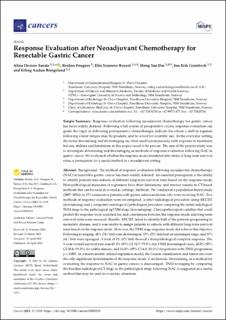| dc.contributor.author | Sandø-Klemmetvoll, Alina Desiree | |
| dc.contributor.author | Fougner, Reidun | |
| dc.contributor.author | Røyset, Elin Synnøve | |
| dc.contributor.author | Dai, Hong Yan | |
| dc.contributor.author | Grønbech, Jon Erik | |
| dc.contributor.author | Bringeland, Erling Audun | |
| dc.date.accessioned | 2023-11-10T09:54:21Z | |
| dc.date.available | 2023-11-10T09:54:21Z | |
| dc.date.created | 2023-05-12T13:43:57Z | |
| dc.date.issued | 2023 | |
| dc.identifier.citation | Cancers. 2023, 5(8), 2318 | en_US |
| dc.identifier.issn | 2072-6694 | |
| dc.identifier.uri | https://hdl.handle.net/11250/3101819 | |
| dc.description.abstract | Background: The method of response evaluation following neoadjuvant chemotherapy (NAC) in resectable gastric cancer has been widely debated. An essential prerequisite is the ability to stratify patients into subsets of different long-term survival rates based on the response mode. Histopathological measures of regression have their limitations, and interest resides in CT-based methods that can be used in everyday settings. Methods: We conducted a population-based study (2007–2016) on 171 consecutive patients with gastric adenocarcinoma who were receiving NAC. Two methods of response evaluation were investigated: a strict radiological procedure using RECIST (downsizing), and a composite radiological/pathological procedure comparing the initial radiological TNM stage to the pathological ypTNM stage (downstaging). Clinicopathological variables that could predict the response were searched for, and correlations between the response mode and long-term survival rates were assessed. Results: RECIST failed to identify half of the patients progressing to metastatic disease, and it was unable to assign patients to subsets with different long-term survival rates based on the response mode. However, the TNM stage response mode did achieve this objective. Following re-staging, 48% (78/164) were downstaged, 15% (25/164) had an unchanged stage, and 37% (61/164) were upstaged. A total of 9% (15/164) showed a histopathological complete response. The 5-year overall survival rate was 65.3% (95% CI 54.7–75.9%) for TNM downstaged cases, 40.0% (95% CI 20.8–59.2%) for stable disease, and 14.8% (95% CI 6.0–23.6%) for patients with TNM progression, p < 0.001. In a multivariable ordinal regression model, the Lauren classification and tumor site were the only significant determinants of the response mode. Conclusions: Downsizing, as a method for evaluating the response to NAC in gastric cancer, is discouraged. TNM re-staging by comparing the baseline radiological CT stage to the pathological stage following NAC is suggested as a useful method that may be used in everyday situations. | en_US |
| dc.language.iso | eng | en_US |
| dc.publisher | MDPI | en_US |
| dc.rights | Navngivelse 4.0 Internasjonal | * |
| dc.rights.uri | http://creativecommons.org/licenses/by/4.0/deed.no | * |
| dc.title | Response Evaluation after Neoadjuvant Chemotherapy for Resectable Gastric Cancer | en_US |
| dc.title.alternative | Response Evaluation after Neoadjuvant Chemotherapy for Resectable Gastric Cancer | en_US |
| dc.type | Peer reviewed | en_US |
| dc.type | Journal article | en_US |
| dc.description.version | publishedVersion | en_US |
| dc.source.volume | 15 | en_US |
| dc.source.journal | Cancers | en_US |
| dc.source.issue | 8 | en_US |
| dc.identifier.doi | 10.3390/cancers15082318 | |
| dc.identifier.cristin | 2147175 | |
| dc.source.articlenumber | 2318 | en_US |
| cristin.ispublished | true | |
| cristin.fulltext | original | |
| cristin.qualitycode | 1 | |

